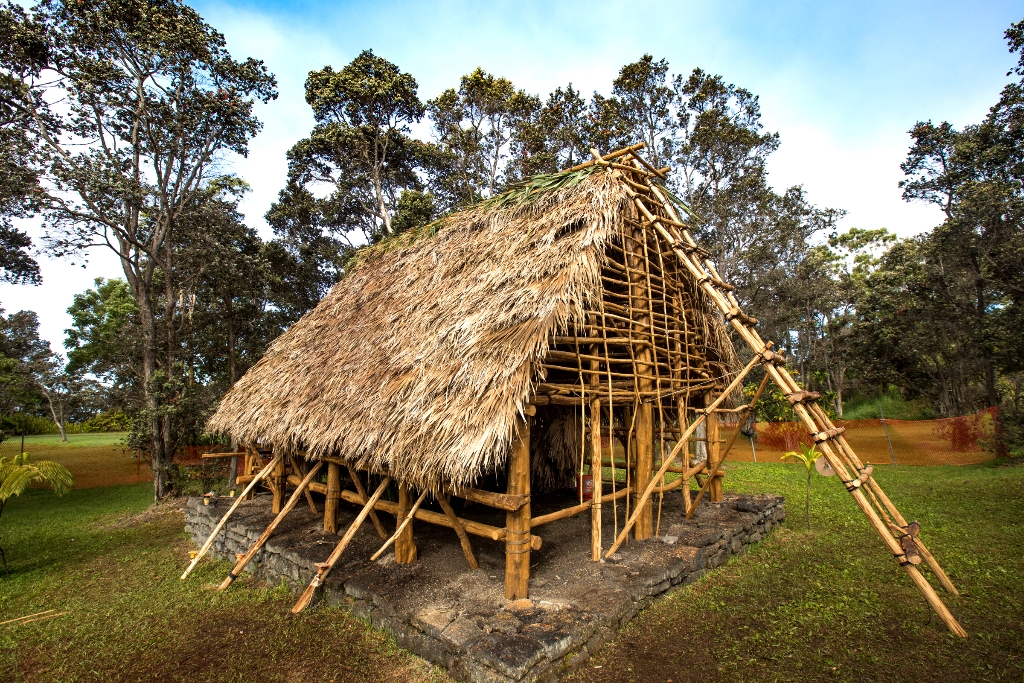
Along the rim of Kīlauea is an area known as Kaʻauea, referenced in Hawaiian chants and oral histories going back hundreds of years. With its cultural significance and its position facing Halemaʻumaʻu crater, the home of the volcano deity Pele, the site was selected as a place to perform hula kahiko with input from kumu hula Edith Kanakaʻole and others. Today visitors will find an elevated kahua hula platform, built in 1979, and a newly constructed hale, a traditional-style Hawaiian house.
The Hale
Built over the course of the summer of 2019 with the help of numerous partners and volunteers, the hale is a reminder of the cultural significance of the Kīlauea summit area.
The building came to life using traditional labor methods with the aid of modern tools. The wooden structure consists of non-native trees— ironwood and kiawe. Incorporating traditional ʻōhiʻa wood posts could have moved fungal pathogens, namely Rapid Ōhiʻa Death, to non-infected trees in the national park. The hale base, constructed by master builder and former park employee Larry Kuamo'o, is made of slabs of lava rock, while the main structural posts sit on pōhaku (large river stone). 'Ili'ili (water-worn pebbles) finish the interior floor. The roof is made of thatched fronds from loulu, palm trees with fan-shaped leaves.
Though few people ever lived directly on the rim of Kīlauea, one of the most active volcanoes on earth, the hale illustrates what traditional life may have looked like elsewhere in Hawai'i Volcanoes National Park and the island of Hawaiʻi. The completed structure allows for further cultural discussion, a place to learn Hawaiian arts and crafts, and opportunities for hālau hula groups to prepare before performing traditional hula on the nearby kahua hula platform.
Although this hale is new, it is only the latest structure in the area. Two other hale were previously built in this spot, in 1981 and 2009. The hale and kahua hula help share kahiko hula and are places where visitors can learn about the traditional Hawaiian culture connected to Hawai‘i Volcanoes National Park.
The Hale
Built over the course of the summer of 2019 with the help of numerous partners and volunteers, the hale is a reminder of the cultural significance of the Kīlauea summit area.
The building came to life using traditional labor methods with the aid of modern tools. The wooden structure consists of non-native trees— ironwood and kiawe. Incorporating traditional ʻōhiʻa wood posts could have moved fungal pathogens, namely Rapid Ōhiʻa Death, to non-infected trees in the national park. The hale base, constructed by master builder and former park employee Larry Kuamo'o, is made of slabs of lava rock, while the main structural posts sit on pōhaku (large river stone). 'Ili'ili (water-worn pebbles) finish the interior floor. The roof is made of thatched fronds from loulu, palm trees with fan-shaped leaves.
Though few people ever lived directly on the rim of Kīlauea, one of the most active volcanoes on earth, the hale illustrates what traditional life may have looked like elsewhere in Hawai'i Volcanoes National Park and the island of Hawaiʻi. The completed structure allows for further cultural discussion, a place to learn Hawaiian arts and crafts, and opportunities for hālau hula groups to prepare before performing traditional hula on the nearby kahua hula platform.
Although this hale is new, it is only the latest structure in the area. Two other hale were previously built in this spot, in 1981 and 2009. The hale and kahua hula help share kahiko hula and are places where visitors can learn about the traditional Hawaiian culture connected to Hawai‘i Volcanoes National Park.
Is there something we missed for this itinerary?
Itineraries across USA

Acadia

Arches National Park

Badlands

Big Bend

Biscayne

Black Canyon Of The Gunnison

Bryce Canyon

Canyonlands

Capitol Reef

Carlsbad Caverns

Channel Islands

Congaree

Crater Lake

Cuyahoga Valley

Death Valley

Dry Tortugas

Everglades

Gateway Arch

Glacier

Grand Canyon

Grand Teton

Great Basin

Great Smoky Mountains

Guadalupe Mountains

Haleakalā

Hawaiʻi Volcanoes

Hot Springs

Indiana Dunes

Isle Royale

Joshua Tree

Kenai Fjords

Kobuk Valley

Lassen Volcanic

Mammoth Cave

Mesa Verde

Mount Rainier

North Cascades

Olympic

Petrified Forest

Pinnacles

Rocky Mountain

Saguaro

Shenandoah

Theodore Roosevelt

Virgin Islands

Voyageurs

White Sands

Wind Cave

Yellowstone

Yosemite

Zion